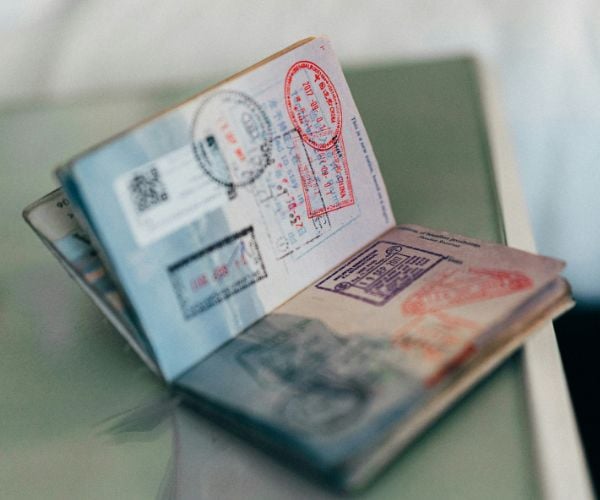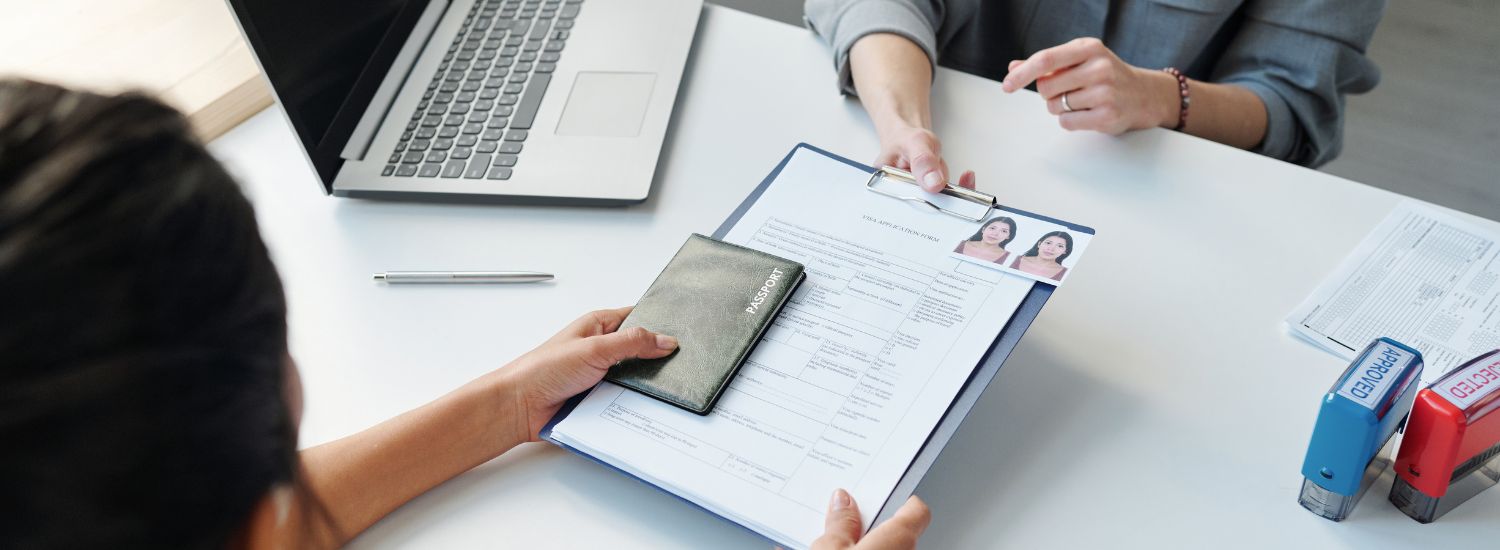Before packing, check this list of items prohibited from entering a particular country or region.
Key takeaways
- A visa is an official document that grants you permission to enter, stay or leave a country for a specified time. In contrast, a passport verifies your identity and citizenship of a particular country.
- To get a visa, determine the one best suited to your needs and eligibility, complete the application on your destination country's visa website, pay a fee and await approval.
- Types of visas include work visas, travel visas, student visas, working holiday visas, marriage visas, humanitarian visas, and golden visas.
- It takes between a day and several years to get a visa, depending on the visa type and destination country.
What is a visa?
A visa is an official travel document that grants people permission to enter, stay or leave a country for a specified time. They are typically attached to passports and are issued by the immigration authorities of your destination country.
Most nations offer multiple visas depending on the purpose of your travel, such as tourism, employment, university, moving abroad or transit. However, having a visa does not guarantee entry, as immigration officers grant final approval at the border. Officials may refuse entry for various reasons, including suspicious behaviour, customs violations and health risks. It's essential to fully understand your visa's requirements before travelling or relocating overseas.
Visa vs passport
A passport is a government-issued document that verifies your identity and citizenship of a particular country. It typically includes a photograph, your name, date of birth, passport number, and issue and expiration date.
On the other hand, a visa is a document linked to your passport that lets you enter a specific country for a particular purpose and duration. You need a passport to apply for a visa, but the two documents serve separate roles.

• Apply for your visa as early as possible, well before your travel date.
• Ensure accuracy and provide up-to-date documents to avoid delays.
• Remain informed by tracking your application process and researching changes in visa policies.
Diligently fill out the application form, ensuring all information matches your supporting documents.
How to get a visa
Getting a visa involves several steps, depending on your destination country and the type of visa you qualify for. Plus, you must meet specific criteria; for example, you might not be able to get a visa if you have a criminal record. Below is a general guide on what to expect during your visa application process.
1. Determine the type of visa you need:
Types of visas include:
- Tourist visa: for short-term travel and leisure purposes.
- Business visa: for work-related activities, such as overseas site visits and conferences.
- Student visa: for long and short-term academic studies abroad.
- Work visa: allowing you to take up employment for a specific time.
- Transit visa: enabling you to pass through one country to another.
2. Check your chosen visa's requirements:
Visit the official website of the embassy or consulate of the country you plan to visit and gather all the required supporting documents and identification you'll need for your application.
Typical documents include:
- A valid passport that lasts at least six months beyond your stay.
- Photographs that meet specific size and format requirements.
- Proof of financial means (often your last three months of bank or savings account statements).
- Travel itinerary (flight and hotel booking confirmation email).
- Proof of job or university placement (usually an acceptance letter).
3. Complete the visa application form:
Diligently fill out the application form, ensuring all information matches your supporting documents. Most applications are completed online via the website or a downloadable form, which you can upload or email when complete.
Alternatively, if you prefer a paper application, you can request it be posted to you or emailed, where you can download it and print it out before posting.
4. Pay the visa fee:
Check online to learn how much your visa costs, including any additional fees like healthcare surcharges and biometric enrollment, then pay. Payments can be made online, via bank transfers, cheques, or in cash at the consulate.

What countries require a visa?
Visa requirements depend on several factors, including your nationality and desired destination. If you're moving to the United States, Canada, China and Russia, these countries require visas from most foreign visitors. Several European Union nations, such as France, Germany and Italy, only require visas from visitors outside the Schengen Area.
Some countries allow visa-free travel or have visa-on-arrival arrangements, often restricted to short-term stays. Websites like Travelscope display a helpful visual representation of the number of nations you can visit visa-free by selecting your origin country.
Always read the rules and requirements of your specific visa before travelling to avoid disruptions.
What countries have the fewest border restrictions?
While all countries need travellers to acquire a visa for extended stays, many have policies and agreements with other nations that allow their citizens to travel visa-free between them.
Below are the top ten countries that grant entry to the most passports visa-free or by issuing an e-visa or visa on arrival, according to the Passport Index.


5. Schedule an appointment:
In some countries, you may need to attend an in-person appointment to submit your application, answer questions about your trip and your background, and provide your biometric data, such as fingerprints, a signature and a photograph. Dress appropriately and bring all requested documents.
6. Wait for your visa application to process:
Processing times can vary depending on the visa type and length, country of origin, etc. You can check the typical processing time for your visa type at your destination country's official website or track your application status via your online account, if available.
7. Collect your visa:
Once your visa is approved, you will typically receive it by mail, or you can collect it from the embassy, consulate, or application centre. Double-check all visa details to ensure everything is correct.
What is an e-visa?
An e-visa is a digitally stored version of a physical visa, the name is a shortening of the term "electronic visa". E-visas offer a convenient alternative for worldwide travellers, increasing accessibility and reducing the need for in-person appointments and lengthy wait times at borders.
E-visas offer faster processing times compared to traditional visa applications. In many cases, approval is granted within days, letting you plan with better flexibility and confidence. Plus, e-visas often have lower fees and reduced paperwork requirements, making them a cost-effective and efficient option.

Types of visas
There are many types of visas, some of the most common being work visas, travel visas, student visas, working holiday visas, marriage visas, humanitarian visas, and golden visas. Below, we look at each of these in more detail:
![]()
Work visa
A work visa allows foreign nationals to live and work in an overseas country for a specific time. Also known as employment, working or skilled worker visas, they typically require sponsorship from an employer in your destination country.
Requirements often include a valid passport, an employment contract and proof of relevant work experience and educational qualifications.
In some countries, expats might also need a work permit in addition to a work visa. This legal document is issued by local labour or immigration departments instead of a consulate or embassy.

How many immigrants are
in the world?

![]()
Travel visa
A travel visa is a document that allows you to visit a country for tourism or leisure. Also known as a visitor or tourist visa, it typically lasts from a few days to several months. It does not permit you to work, study, do business or become a permanent citizen of that country.
Requirements vary but generally include a passport from an approved country with at least six months validity, a completed application form, a recent photograph, and an administration fee.
![]()
Student visa
A student visa lets you reside in a foreign country for an agreed amount of time to study at an accredited institution. To apply, you'll need an acceptance letter from the school, college, or university, a valid passport, proof of financial means, and certification demonstrating your ability to read, write, and speak the language of your destination country.
Student visas often allow you to work part-time and may include conditions such as regular attendance and good behaviour.
![]()
Working holiday visa
A working holiday visa lets young people (aged 18-35) live and work in a different country for an agreed time, typically a year. It aims to promote cultural relations between nations and allow young adults to fund their travels through temporary employment while learning a new language and broadening their horizons.
Examples include the UK's Youth Mobility Scheme, Canada's International Experience Canada and Australia's Working Holiday Maker. Requirements include proof of funds, health insurance and a return ticket.
![]()
Marriage visa
A marriage visa enables a foreign spouse to join their partner in another country. Alternative names include spouse, family reunification, partner and dependent visas. They last for a few years before requiring renewal. Once a certain amount of time has passed, often five or so years, you can apply for permanent settlement.
To get a marriage visa, you need to prove the validity of your union with a marriage certificate, photographs and evidence of joint financial responsibilities. Further requirements may include health and criminal history checks and in-person interviews.
![]()
Humanitarian visa
A humanitarian visa, also known as a refugee or asylum visa, is granted to individuals fleeing conflict, persecution, or natural disasters in their home country. It allows temporary refuge in a safer country that can provide protection and access to essential needs, such as food and shelter.
Humanitarian visas require proof via multiple forms of identification and often involve interviews and background checks. Applicants must demonstrate a credible risk to their well-being if they were to return to their home country.
![]()
Golden visa
Golden visas offer fast-tracked residency or citizenship to immigrants willing to make significant investments in their host country, such as housing purchases, business investments or government bonds. Popular countries that offer this type of visa include Portugal, Spain, Greece, Malta, Australia, Canada, Italy, the USA and the UK.
Alternative names include investor, wealth and VIP visas. Golden visa holders may enjoy benefits like visa-free travel, tax incentives, and access to higher education and quality healthcare.
Do you need a visa to go to Europe?
Whether you need a visa to visit Europe depends on your nationality, which passports you hold, and which countries you plan to visit. Citizens from several countries, including the United States, United Kingdom, Australia and Japan, can travel visa-free to the European Union (EU) and Schengen Area nations for up to 90 days within 180 days. However, travellers from other regions and non-Schengen Area nationals planning longer stays for work or study must apply for a visa.

Avoid unnecessary delays by applying before your desired travel date and completing the paperwork accurately.
How much is a visa?
Visa costs vary by country, type, length and purpose. Depending on the destination, a visitor visa may range from USD26 to USD230. Student and work visas typically cost several hundred dollars, sometimes exceeding USD1,000.
Total costs may include processing fees, express service fees, healthcare charges, biometrics and charges for particular documents like health certificates.
How long does it take to get a visa?
The time it takes to get a visa varies by country and the type of visa you are applying for. Short-term visas, such as tourist and transit visas, are typically processed within a few days or weeks. However, student and work visas take several weeks to months.
Several factors influence processing times, including the current volume of applications, the accuracy of your application details and documentation, and the specific requirements of the issuing country. Avoid unnecessary delays by applying before your desired travel date and completing the paperwork accurately.
The following are some typical visa wait times for a few of our most popular destinations*:
| Country | Visa type | Wait time |
| United Kingdom | Standard visitor | 3 weeks |
| Student | 3 weeks | |
| Skilled worker | 3 weeks | |
| Partner/spouse | 24 weeks | |
| Australia | Visitor | 1 day |
| Permanent skilled worker | 5 months | |
| Student | 24 days | |
| Partner | 7 months | |
| Canada | Visitor | 1 month |
| Work | 8 months | |
| Spouse | 17 months | |
| Study | 2 months |
*wait times are accurate as of 2024 and dependent on several factors, including the current backlog.
Sources: gov.uk, immi.homeaffairs.gov.au, canadim.com

What does a visa look like?
Visas commonly appear as stamps or stickers within your passport. They were separate documents in the past, but they are almost always glued or stamped to a page inside your passport nowadays. Visas hold vital information that border officials can reference, such as your name, photograph, nationality, passport number, visa type and expiration date.
E-visas do not include a physical format. Approval is linked to your passport number and verified online by border officials.
Visa example
While every country's visa looks slightly different, each follows a similar format. Below is a basic example of a visa layout and explanations of the fields you'll typically encounter.

- Issuing Post Name: the location of the embassy or consulate that issued the visa.
- Control Number: the visa control number is a string of digits assigned by the immigration department of your destination country to keep track of visa issuances.
- Surname and Given Name: your name should match the name on your passport exactly.
- Visa and Type/Class: these two fields indicate the visa classification and describe the purpose of your travel.
- Passport Number: this number must match the number on your passport.
- Sex: your gender must match the type recorded on your passport.
- Birth Date: this must match the date recorded on your passport.
- Nationality: this should denote your country of birth.
- Entries: the number here tells you how many times you may apply for entry to your destination country.
- Issue Date: the date when the embassy or consulate issued your visa.
- Expiration Date: the date your visa expires is the last date you may seek entry into your destination country.
- Annotation: this area will contain any additional information about your visa.

What is a visa number?
A visa number is a unique identifier assigned to your visa. It is usually found on the visa itself (highlighted in yellow in the diagram above) and attached to your passport. Your e-visa number is in your confirmation email or the attached PDF document.
They are an essential reference for both the visa holder and immigration authorities. The visa number is used for:
- Tracking the status of your visa application.
- Tracking your movement in and out of countries.
- Managing renewals.
- Verifying your status with immigration authorities.
- Resolving issues related to your stay.
How long does a visa last?
The duration of a visa depends on its type and the issuing country. Transit visas typically last from twenty-four hours to a couple of weeks, tourist visas can last up to several months, while student and work visas can be valid for multiple years.
Some visas are single-entry and expire once you leave the country, while others are multiple-entry, allowing several visits within a specified period. Always check the validity and conditions of your visa to avoid overstaying, which may lead to penalties or re-entry bans.










